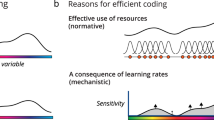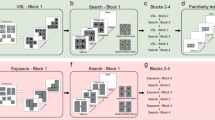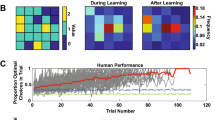Abstract
We studied the transition of stimuli from novel to familiar in visual search and in the guidance of attention to a particular object. Ability to identify an object improved dramatically over several days of training. The learning was specific for the object's position in the visual field, orientation and configuration. Improvement was initially localized to one or two positions near the fixation spot and then expanded radially to include the full area of the stimulus array. Characteristics of this learning process may reflect a shift in the cortical representation of complex features toward earlier stages in the visual pathway.
This is a preview of subscription content, access via your institution
Access options
Subscribe to this journal
Receive 12 print issues and online access
$209.00 per year
only $17.42 per issue
Buy this article
- Purchase on Springer Link
- Instant access to full article PDF
Prices may be subject to local taxes which are calculated during checkout




Similar content being viewed by others
References
Treisman, A & Gelade, G. A feature integration theory of attention . Cognit. Psychol. 12, 97– 136 (1980).
Sagi, D. & Julesz, B. ‘Where’ and ‘what’ in vision. Science 228, 1217– 1219 (1985).
Duncan, J. & Humphrey, G. W. Visual search and stimulus similarity . Psychol. Rev. 96, 433– 458 (1989).
Rubinstein, B. S. & Sagi, D. Spatial variability as a limiting factor in texture-discrimination tasks: implications for performance asymmetries. J. Opt. Soc. Am. A 7, 1632– 1643 (1990).
Wang, Q., Cavanagh, P. & Green, M. Familiarity and pop-out in visual search. Percept. Psychophys. 56, 495–500 (1994).
Maljovic, V. & Nakayama, K. Priming of pop-out detection: role of features. Mem. Cognit. 22, 657– 672 (1994).
Maljovic, V. & Nakayama, K. Priming of pop-out: II. role of position. Percept. Psychophys. 58, 977– 991 (1996).
Sireteanu, R. & Rettenbach, R. Perceptual learning in visual search: fast, enduring but non-specific. Vision Res. 35, 2037–2043 (1995).
Efron, R. & Yund, E. W. Guided search: the effects of learning . Brain Cogn. 31, 369–386 (1996).
Karni, A. & Sagi, D. Where practice makes perfect in texture discrimination: evidence for primary visual cortex plasticity. Proc. Natl. Acad. Sci. USA 88, 4966– 4970 (1991).
Schneider, W. & Shiffrin, R. M. Controlled and automatic human information processing: I. detection, search and attention. Psychol. Rev. 84, 1–66 ( 1977).
Shiffrin, R. M. & Schneider, W. Controlled and automatic human information processing: II. perceptual learning, automatic attending and a general theory. Psychol. Rev. 84, 127–191 (1977).
Treisman, A., Verira, A. & Hayes, A. Automaticity and preattentive processing. Annu. Rev. Neurosci. 105, 341–362 (1992).
Ahissar, M. & Hochstein, S. Learning pop-out detection: specificities to stimulus characteristics. Vision Res. 36, 3487–3500 (1996).
Braun, J. Vision and attention: the role of training. Nature 393, 424–425 (1998).
Ahissar, M. & Hochstein, S. Attentional control of early perceptual learning. Proc. Natl. Acad. Sci. USA 90, 5718–5722 (1993).
Ito, M., Westheimer, G. & Gilbert, C. D. Attention and perceptual learning modulate contextual influences on visual perception. Neuron 20, 1191–1197 (1998).
Fahle, M. & Morgan, M. No transfer of perceptual learning between similar stimuli in the same retinal position. Curr. Biol. 6, 292–297 ( 1996).
Crist, R. E, Kapadia, M., Westheimer, G. & Gilbert, C. D. Perceptual learning of spatial localization: specificity for orientation, position and context. J. Neurophysiol. 78, 2889–2894 (1997).
Shiu, L. P. & Pashler, H. Improvement in line orientation discrimination is retinally local but dependent on cognitive set. Percept. Psychophys. 52, 582–588 (1992).
Ahissar, M. & Hochstein, S. Task difficulty and the specificity of perceptual learning. Nature 387, 401– 406 (1997).
Bravo, M. J. & Nakayama, K. The role of attention in different visual search tasks. Percept. Psychophys. 51, 465–472 (1992).
Wolfe, J. M. in Current Directions in Psychological Sciences 124– 128 (Cambridge Univ. Press, Cambridge, 1992).
Wolfe, J. M., Cave, K. R. & Franzels, S. R. Guided Search: an alternative to the feature integration model of visual search. J. Exp. Psychol. Hum. Percept. Perform. 15, 419–433 ( 1989).
Joseph, J. S., Chun, M. M. & Nakayama, K. Attentional requirements in a preattentive feature search task. Nature 387, 805–807 (1997).
Chun, M. M. & Jiang, Y. Contextual cueing: implicit learning and memory of visual context guides spatial attention. Cognit. Psychol. 36, 28–71 ( 1998).
Braun, J. & Sagi, D. Vision outside the focus of attention . Percept. Psychophys. 48, 45– 58 (1990).
Nakayama, K. & Joseph, J. S. in The Attentive Brain (ed. Parasuraman, R.) 279–298 (MIT Press, Cambridge, Massachusetts 1997).
Fiorentini, A. & Berardi, N. Learning in grating waveform discrimination: Specificity for orientation and spatial frequency . Vision Res. 21, 1149– 1158 (1981).
Nazir, T. A. & O'Regan, J. K. Some results on translation invariances in the human visual system. Spat. Vis. 5, 81–100 (1990).
Kapadia, M. K., Ito, M., Gilbert, C. D. & Westheimer, G. Improvements in visual sensitivity by changes in local context: Parallel studies in human observers and in V1 of alert monkeys. Neuron 15, 843–856 (1995).
Posner, M. I. & Gilbert, C. D. Attention and primary visual cortex. Proc. Natl. Acad. Sci. USA 96, 2585 –2587 (1999).
Sillito, A. M., Grieve, K. L., Jones, H. E., Cudeiro, J. & Davis, J. Visual cortical mechanisms detecting focal orientation discontinuities. Nature 378, 492–496 (1995).
Das, A. & Gilbert, C. D. Topography of contextual modulations mediated by short-range interactions in primary visual cortex. Nature 399, 655–661 ( 1999).
Darian-Smith, C. & Gilbert, C. D. Axonal sprouting accompanies functional reorganization in adult cat striate cortex. Nature 368, 737–740 ( 1994).
Gilbert, C. D., Das, A., Ito, M., Kapadia, M. & Westheimer, G. Spatial integration and cortical dynamics. Proc. Natl. Acad. Sci. USA 93, 615– 622 (1996).
Acknowledgements
We thank R. Crist for discussions and comments on the manuscript. This work was supported by NIH grant EY07968 and a Burroughs Wellcome fellowship to M.S.
Author information
Authors and Affiliations
Corresponding author
Rights and permissions
About this article
Cite this article
Sigman, M., Gilbert, C. Learning to find a shape. Nat Neurosci 3, 264–269 (2000). https://doi.org/10.1038/72979
Received:
Accepted:
Issue Date:
DOI: https://doi.org/10.1038/72979
This article is cited by
-
Priority coding in the visual system
Nature Reviews Neuroscience (2022)
-
Visual search performance is predicted by both prestimulus and poststimulus electrical brain activity
Scientific Reports (2016)
-
Neural plasticity in high-level visual cortex underlying object perceptual learning
Frontiers in Biology (2013)
-
Tilt aftereffect from orientation discrimination learning
Experimental Brain Research (2011)
-
Visual perception and memory systems: from cortex to medial temporal lobe
Cellular and Molecular Life Sciences (2011)



